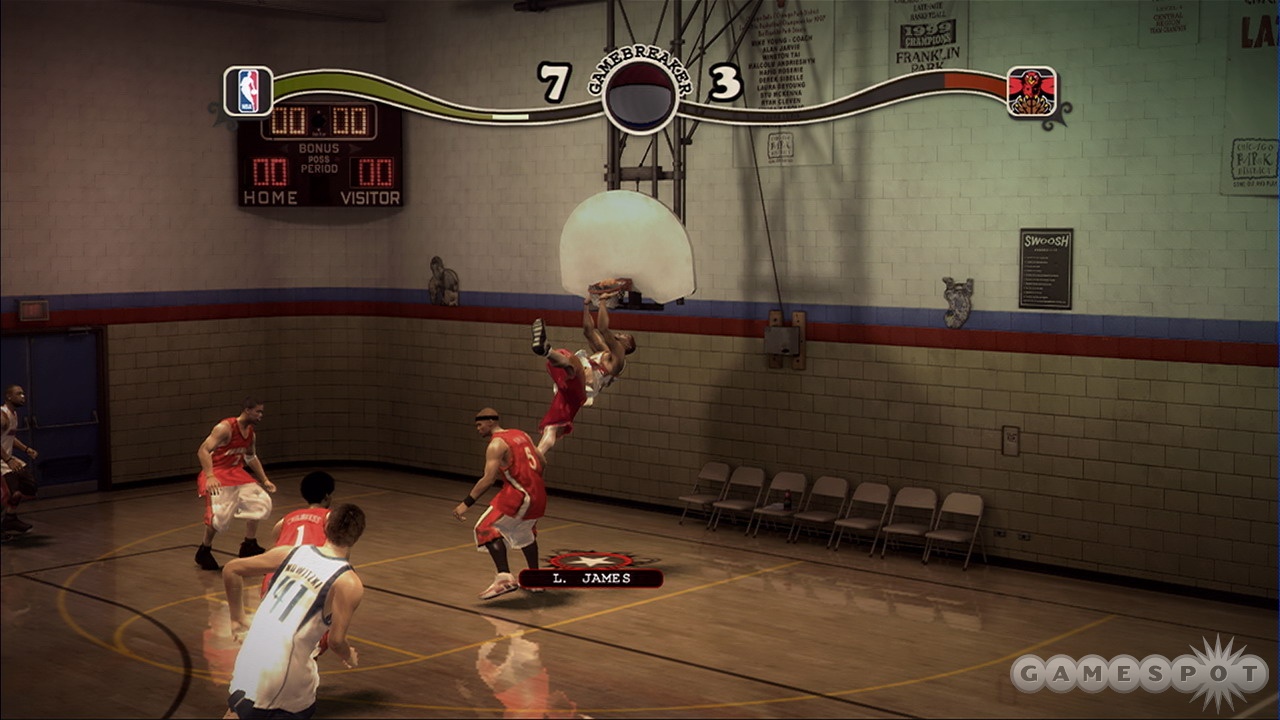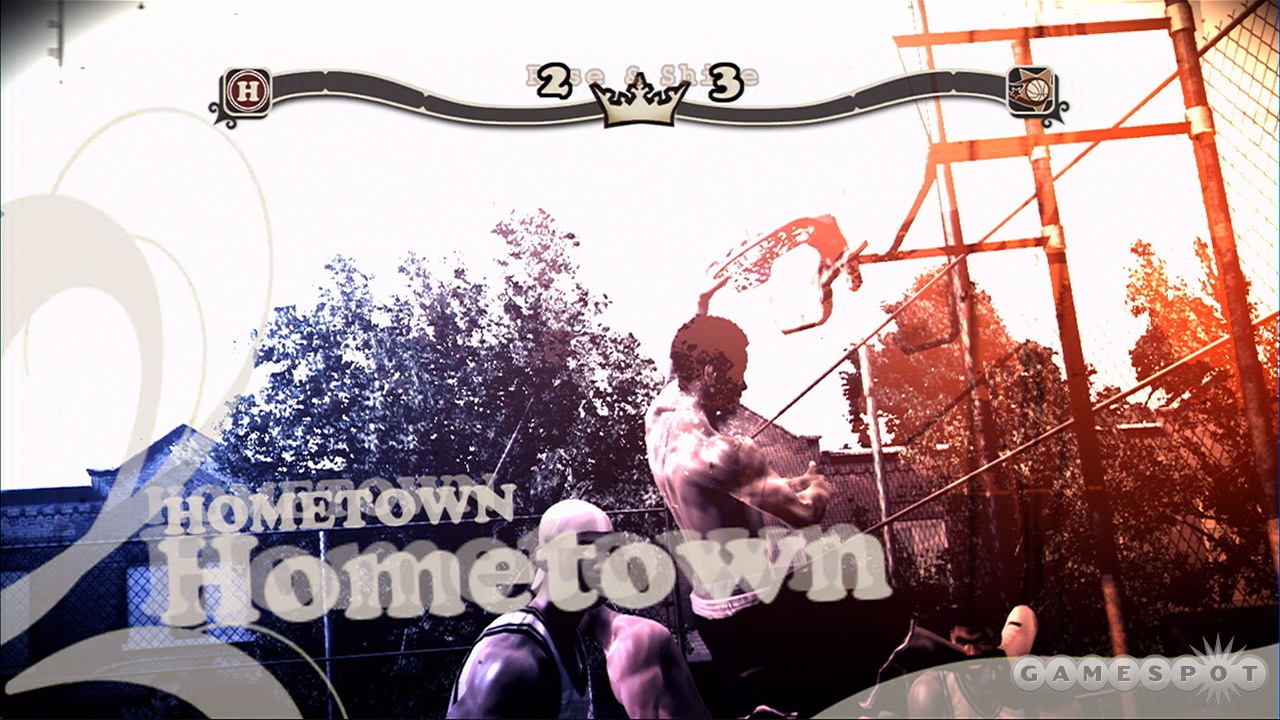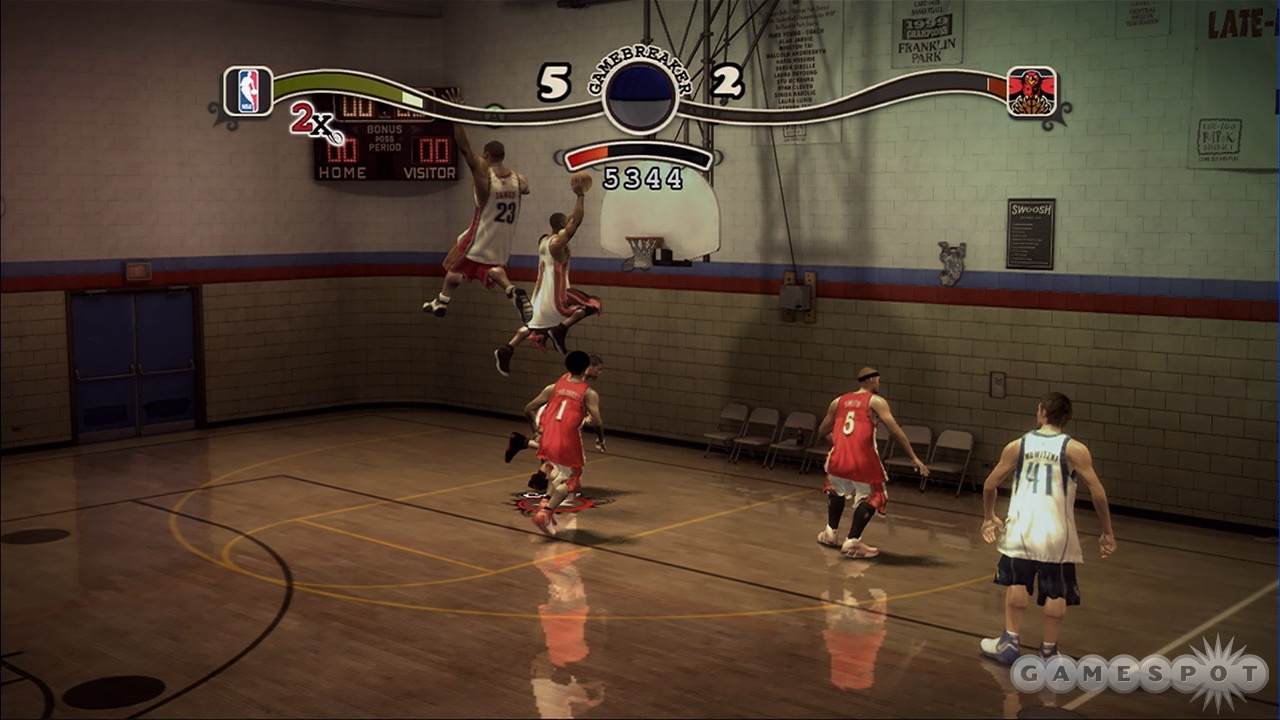NBA Street Homecourt First Look
Rim-rocking double dunks and break dancing on the asphalt--we check out the over-the-top antics of the next-gen debut for the NBA Street series.
At some point in a typical game of NBA Street Homecourt, a player is going to leap up into the air, dunk the ball into the basket, grab the ball before it hits the ground, contort into a backflip off the backboard, and slam the ball through the hoop one more time. Later on in the match, someone is going to pop a gamebreaker and begin break-dancing with the basketball to the musical accompaniment of Herbie Hancock's "Rock It." Later, one of your teammates might kneel on the ground, giving you a perfect opportunity to run, leap off his back, and pull off some of the sickest dunks you've ever seen in a basketball game. Yeah, this is NBA Street, alright--NBA Street Homecourt, to be precise, the debut of the series of the PlayStation 3 and Xbox 360. With its dunk-first, ask-questions-later gameplay and move sets straight out of Cirque du Soleil, it takes a while to get back into the NBA Street swing of things, but, with the fifth game in the series, EA Sports Big is bringing the tried-and-true formula into the HD era.

On the off chance you've never played an NBA Street game before, the series features a mix of real-life NBA stars along with fictional players and, of course, your created ballers, going up against one another in an over-the-top series of three-on-three matchups in which gravity is merely a suggestion and style counts just as much as points. The NBA Street series has long been known for its in-depth trick system. The previous game in the series, NBA Street V3, featured a complex trick setup that utilized both analog sticks in various combinations. With Homecourt, the tricks return to the face buttons--you use the Y and X buttons to perform tricks and crossovers, both of which can be modified by holding down either the LB or RB button. The kind of crossover you pull off, as well as its depth and speed, depends on how long you hold down the button; if you press the crossover button in rapid succession, you'll pull off a quick series of low dribble crossovers and build up your gamebreaker meter that much quicker. To pass, you simply press the A button. Dunks and shots are executed with the B button.
Once you've got the basics down, it's time to move on to the more complex moves in your arsenal. Much like the refined trick system in Homecourt, dunks are at once simple and complex, thanks to an elegant system that executes different dunks based on how long you hold down the dunk button. Tap the dunk button for a quick layup or hold it down for increasingly more over-the-top slams. A meter will appear over your player to give you an idea of the timing of the slam--if you hold it until just the right time, you can pull off the incredible double-dunk move described above. Of course, hold the button too long and your player might end up with his foot in the basket, or plastered up against the backboard.
Homecourt also includes an approximation of set plays. For example, by pressing the L3 button you can call for a screen. You can send a teammate hurtling into the air for a huge alley-oop by pressing up on the directional pad. An icon will appear over the leaping player's head, and to complete the alley-oop, you simply press that button. Once the in-air player has the ball, however, you've got a few options. You can either continue the slam yourself, or dish the ball back out to another player. In some cases, a second teammate will leap into the air behind you; here, you can pass the ball to him to complete a truly impressive three-man alley-oop.
By pressing down on the D pad you can call for a player to get down on the ground and prepare to launch your player into the air, over your opponents, and toward the basket for a massive dunk. It sounds complex, but all you really need to do is move your controlled player toward your teammate and press the circle button. Time it right and your player will jump on the back of the crouched teammate, only to be launched into the air for a rim-rocking dunk.

Then there are the gamebreakers--which are, of course, an integral part of any Street game. By building up tricks you earn gamebreaker points. Fill up your gamebreaker meter completely and you can activate your gamebreaker by moving your player to an illuminated circle in the middle of the court and pressing the triangle button. From there, the familiar jazzy strains of "Rock It" will begin, and you can begin putting on a show of your best popping-and-locking b-ball tricks. When you initiate a gamebreaker, you automatically subtract one point from your opponent, with the potential to add one or more points to your total.
The more tricks you pull off during a gamebreaker, the more potential bonus points you can earn once you actually put the ball through the hoop. Keep in mind there's still a shot clock to contend with, so you're going to have to put the ball up at some point. Also, gamebreakers are not necessarily a sure bet--just as in the regular game, you can lose the ball and give up possession of the gamebreaker to your opponent. In fact, it isn't unusual for players to switch possession of gamebreakers several times.
Homecourt isn't just about offense--there's a defensive presence to the game as well. Perhaps more so than in previous NBA Street games, contact plays a big role in Homecourt. For example, when playing on defense, one of the most effective weapons is your ability to shove players off the ball. If you've got a powerful bruiser on your team, you'll want to make sure he is in between your opponent and the basket as much as possible. Move your defender close to an opponent and you can shove him by pressing the triangle button or swipe at the ball with the square button. Push him (or her) hard enough and your opponent will lose control of the ball altogether--at that point, it's time to swoop in with your speedier players and grab the rock. In addition, you can move in on players without the ball, such as shoving a crouching opponent out of the way before he can send his teammate in for a big dunk.

One gameplay aspect Homecourt seems to get right is the physical presence of the players on the court. A small-fry guard will be crushed underfoot if you try to send your forward off his back for a dunk; similarly, it's easier to get in the way of the smaller guys when they make their way in toward the rim. The smaller guys are typically better ball handlers, while the bigger, more powerful players can't be trusted with long trick chains, or even to pick up a loose ball on the run.
These physical differences are something you'll want to keep in mind when creating your player in the game's homecourt challenge mode, Homecourt's equivalent of a career mode. You'll have some options when it comes to the look of your character, but first you'll want to pick a position from one of three: guard, forward, or center. Once you've chosen your position, it's time to select from a number of preset characters. Each has skills and specialties all his own--some will be shot makers, others will be great at ball handling or dunking. Then you can customize your player's face with the analog sticks. The face-morphing technology is impressive here--you can change your player into a dead ringer for an NBA pro like Tony Parker or Tim Duncan, or go your own way and give your Street alter ego a look all his own.
Once you've got your created baller, it's time to hit the streets and start playing for respect. You'll find plenty of teams to challenge right away, along with four different difficulty levels to play at. The rules change depending on the challenge: Some games will be the first to 7, 15, or 21; in others, the winning team is the first one to build a three-point lead; in still others, only dunks will count; and so on. Winning games not only ups your various attributes, it increases your player level as well, which, in turn, ups the maximum attainable rating for your attributes.
Once you hit level five, you'll earn a "freak skill," which will let you choose one of your attributes to max out immediately. Do you want your player to be nails from beyond the arc? How about a passing machine like Steve Nash? Choose wisely here, as the freak skill is an obviously valuable--and rare--upgrade. Your ultimate aim in homecourt mode will be to upgrade your created player up to level 20, where you'll then earn your "master skill," an unstoppable attribute that will prove to be your deadliest weapon on the court. A master stealer, for example, will be able to swipe the ball from an opponent 100 percent of the time, while a master blocker will be able to block every shot that comes his way. The producers behind Homecourt had one goal in mind when developing this mode: to help the player ensure that their created baller is "the man" when it comes to his on-court skills, not merely a bit player among more-skilled NBA players. Once you've gained your master skill, you can take your perfected player online and go up against other players in one-on-one battles.
The goal in homecourt challenge mode will be to beat the NBA's best on their home turf, such as taking down Homecourt cover star Carmelo Anthony at Baltimore's Cloverdale Courts. As your rep grows, so too will the legend of your hometown court. As you progress through the mode, you'll move up the ladder and begin taking on real NBA talent; you'll also have the ability to recruit NBA players to your team--and they are usually a big upgrade from the fictional players you start out with.
Other modes in Homecourt include gamebreaker battle, trick battle, custom game, back to basics, practice, and quick play mode. Gamebreaker battles only count points you score while in gamebreaker mode, while trick battles are contests to see who can fill up his or her gamebreaker meter first. Back to basics strips out all the extraneous trickeration out of the Street series and features simple three-on-three hoops, while practice mode is an ideal place to try out different trick combinations.

One of the coolest aspects of Homecourt is its mix of modern-day graphical prowess combined with an old-school aesthetic that, well, keeps it real. The intro movies have a muted, washed-out look that resembles something straight out of an old home movie, and the lighting effects and design from one court to the next show off a nice variety in tone. The retro feel extends to the music--in addition to the aforementioned "Rock It," the menus feature old-school instrumental funk tracks that really benefit the streetwise feel of the game.
Jumping into the PS3 and Xbox 360 era of video games at full speed, the producers of NBA Street Homecourt are quick to point out that the game has been built from the ground up, as evidenced by the combination of new-jack technology and old-school design, the time-tested, trick-based gameplay that aims to be approachable for beginners while skimping on none of the depth series vets have come to expect, as well as the over-the-top stunt animations that are sure to garner more than a few "oohs" and "ahhs." In all, it's NBA Street for the next generation, and it will be coming to a game store near you soon. Stay tuned for more updates on this game in the coming weeks. In the meantime, if you have specific questions about the game, hit us up in the NBA Street Homecourt forums and we'll do our best to answer them as quickly as possible.
Got a news tip or want to contact us directly? Email news@gamespot.com
Join the conversation